Diesel Exhaust Fluid
Understanding how to Deal with DEF
Article Date: December, 2018
Article and Photography by Mark Quasius
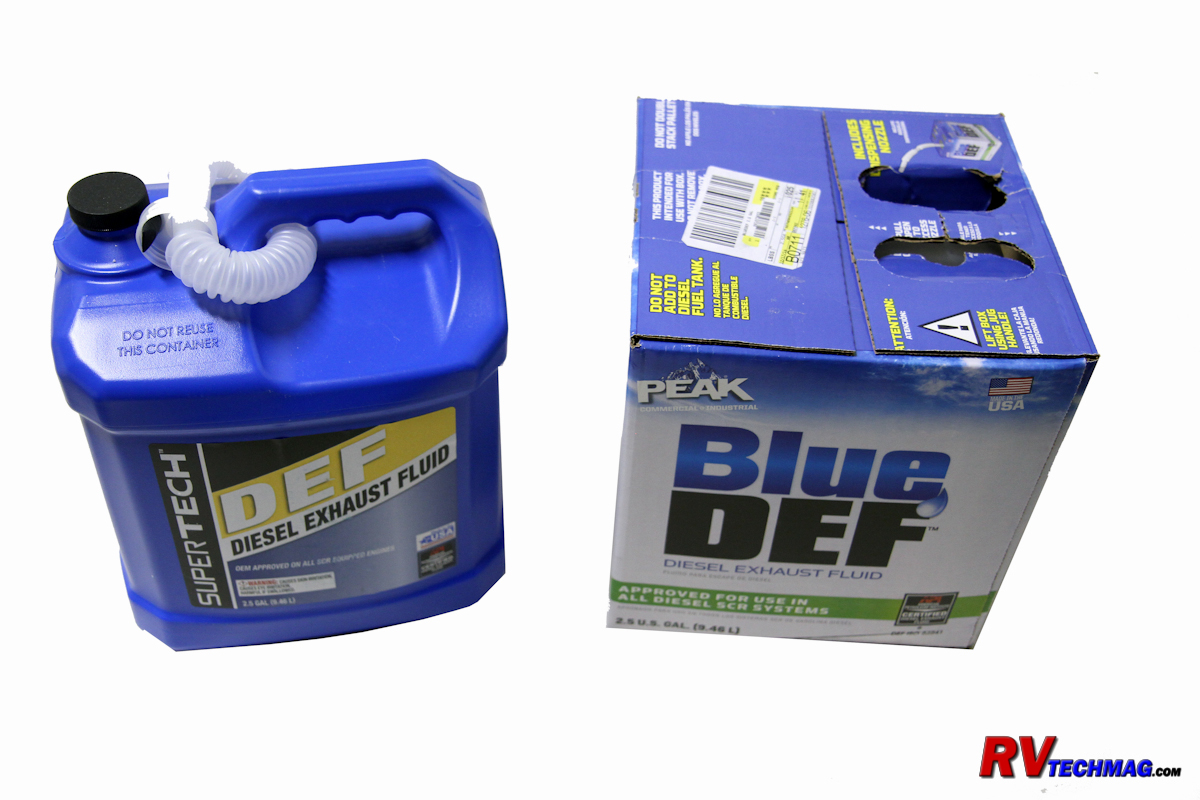
Ever stringent reductions in heavy duty diesel engine emissions have been mandated by the EPA in recent years. The first big
change was the use of Diesel Particulate Filters (DPF) in the EPA-2007 regulations. This required the use of Ultra Low Sulfur (ULSD) Diesel fuel to prevent
damaging the costly DPF. The reduction in emissions was noticeable but he biggest change was in the EPA-2010 specs which required even more stringent
limits on emissions. While some engine manufacturers attempted to use advanced Exhaust Gas Recirculation as a method, these efforts caused more heat related
problems and just didn't work out very well. Cummins decided to implement a Selective Catalytic Reduction (SCR) system, which continued the use of the DPF
but added a second component, the SCR, to the system. This system has resulted in significant gains in reducing emissions and resulted in greatly improved
air quality.
The SCR system adds a decomposition reactor after the Diesel Particulate Filter. Diesel Exhaust Fluid (DEF) is injected into the
exhaust stream where it forms ammonia vapor. This vapor flows along with the Nitrogen Oxides (NOX) in the exhaust as they enter the next chamber, which is the
SCR catalyst, where they react together to form harmless water vapor and nitrogen. The end result is that the emissions are at near-zero levels. By performing
this emissions treatment in the exhaust, rather than in the engine, it allows the engine manufacturer to tune their engines for maximum performance, fuel
efficiency and reliability. The only drawback is that owner now needs to add DEF to the system on a regular basis and care for the DEF in the proper manner.
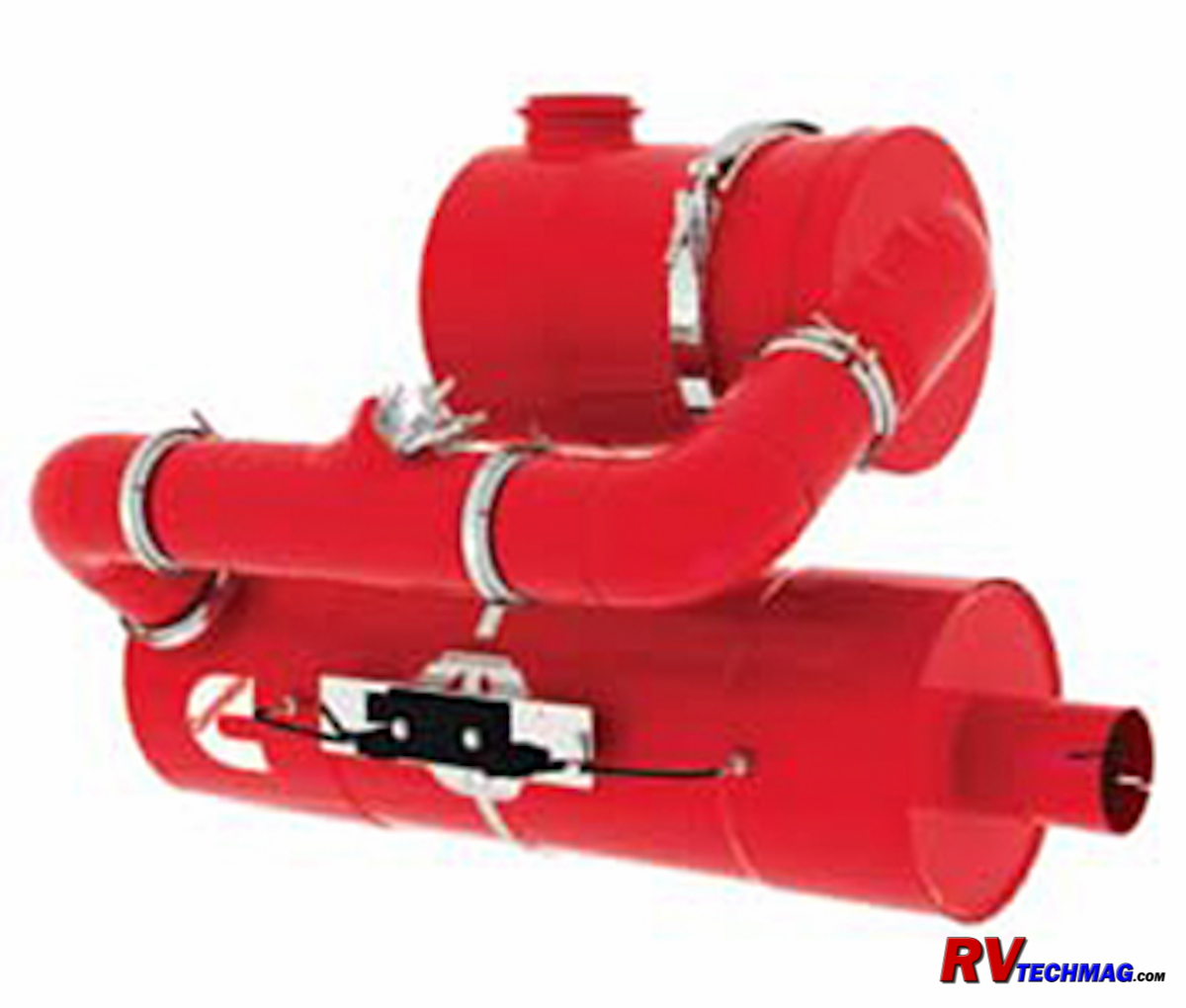
The Cummins aftertreatment system utilizes SCR
emisions technology to achieve reduced emissions levels
What Is DEF?
Diesel Exhaust Fluid, commonly referred to as DEF, is designed specifically for use in diesel engine emissions systems. It's a
non-hazardous mixture of 32.5% urea (ammonia) and 67.5% water. DEF systems are picky so don't even think about mixing up your own stuff with some household
ammonia. If you mess up your emissions system there can be some significant repair bills looming in your future. There is no good-better-best DEF. All DEF is
rated by the American Petroleum Institute (API) who rate engine oils and other lubricants. DEF isn't all that complicated so any DEF the carries the API certified label on their packaging will be just fine. Feel free to shop for the best price and availability but just be sure it has the API label on the
container.
DEF production is governed by the ISO 22241 standard to ensure that the DEF has an exact 32.5% content of ammonia. This ratio was
selected because it offers the lowest possible freezing temperature of DEF, which is 12 degrees Fahrenheit. Strict tolerances are also placed on impurities,
which can damage injectors and catalysts. The quality of the urea is also monitored and urea such as used in fertilizer is not allowed plus only distilled
or deionized water may be used. Even the DEF containers are regulated by the ISO standard because DEF is corrosive to carbon steel, copper and aluminum so
these containers may not be used.
How Much DEF Will I Use?
Numerous sources make statements as to what your DEF usage will be but the fact is that it will vary. One common statement is that
DEF will equal 2% of your fuel usage but this is a generalization. A lighter RV with a smaller engine that is driven more leisurely may consume as low as
1.5% while as heavier coach with a large 15 liter diesel engine that is driven more spiritly may have a DEF consumption ratio as high as 4% of the fuel rate.
Let's assume that your motorhome does burn DEF at a 2% rate. If your coach has a 150 gallon fuel tank, has fuel economy of 6 MPG and a DEF tank capacity of
13 gallons your DEF will need to be refilled once for every four fuel tank refills - even longer if you top off your fuel tank more often with letting it get
too low. So DEF usage isn't big concern. There is a cost to buying DEF but it's not significant and the latest SCR equipped engines that use DEF generally
have a slight improvement in fuel economy so cost-wise it's pretty much a wash.
Handling DEF
|
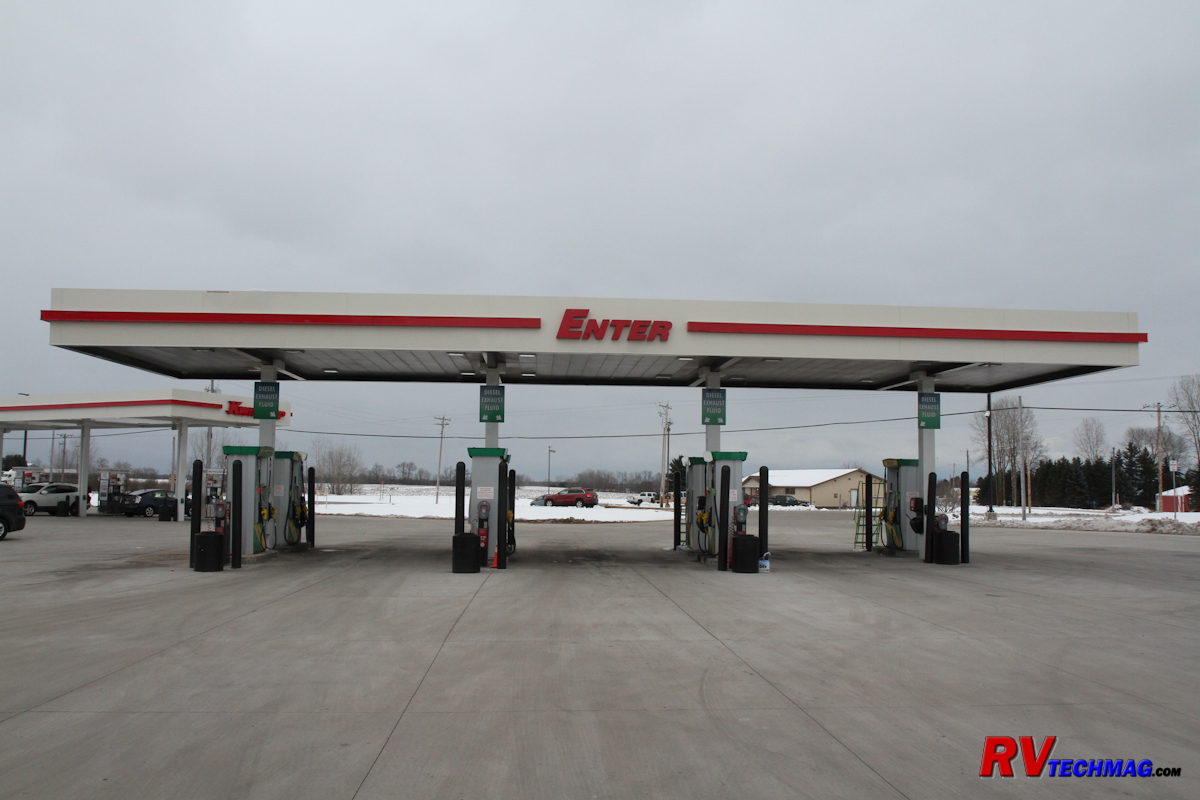
Many truck stop fuel islands are equipped with DEF pumps to provide easy access to DEF when refueling.
|

Diesel fuel islands equipped with DEF pumps generally incorporate overhead signage indicating where DEF pumps are located.
|
Handling DEF doesn't take an engineering degree or a hazmat suit but there are a few things to keep in mind. DEF can be purchased in
2.5 gallon containers at auto parts stores or large retailers, such as Wal-Mart. DEF is also dispensed from dedicated DEF pumps at most major truck stops.
The DEF nozzle is kept behind a magnetic flap in a heated compartment right alongside the diesel fuel pump to prevent freezing during cold temperatures.
Most truck stop fuel islands will have overhead signage that indicates which lanes have pump DEF available.
DEF does have the potential to evaporate. After all it is 67.5% water but field tests have found this is not a significant concern
as long as the DEF tank is securely closed. DEF does have a shelf life or 2 years and this will be reduced if the DEF is exposed to direct sunlight or if
the temperature remains above 85 degrees Fahrenheit for sustained periods. DEF packaging will have an expiration date so keep that in mind if you plan on
stocking up on DEF. In an ideal world your DEF should be stored where temperatures do not drop below freezing or exceed 85 degrees and will be consumed
within one year.
|
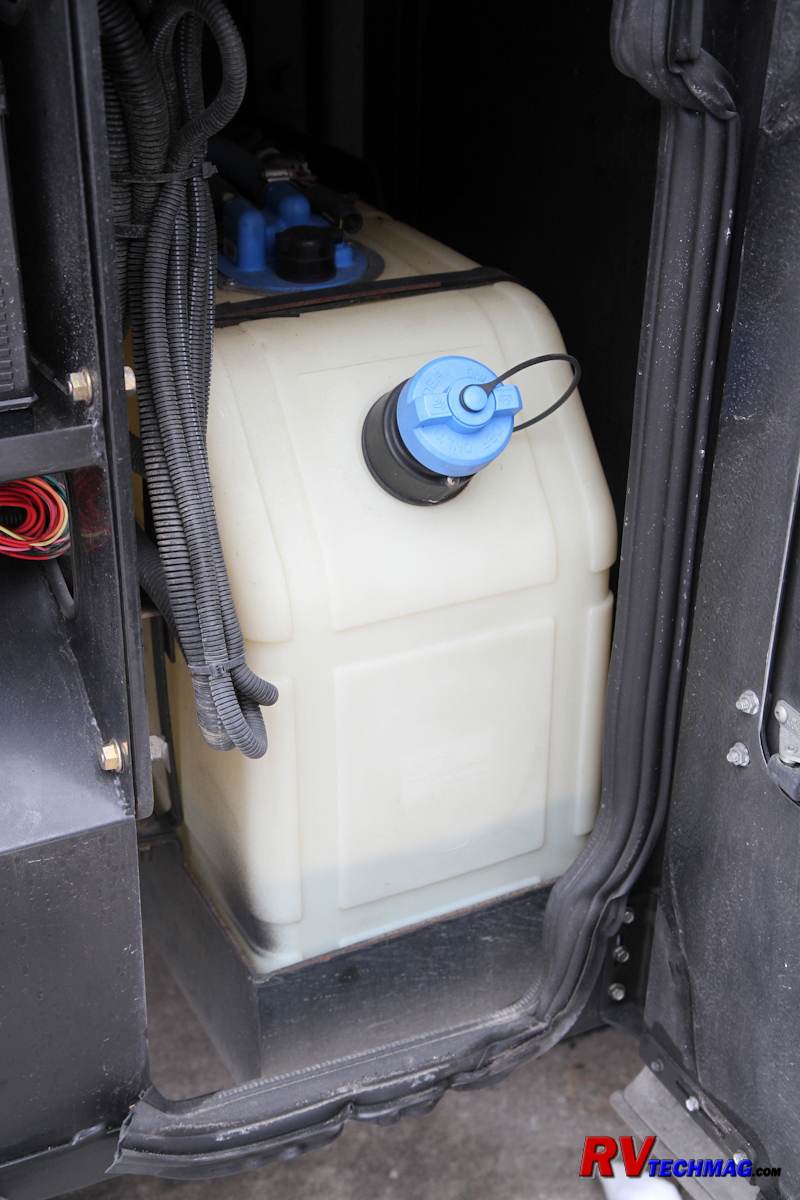
DEF tanks are need to be located close to the engine due to limits on the length of hose bnetween the tank and dosing valve.
|
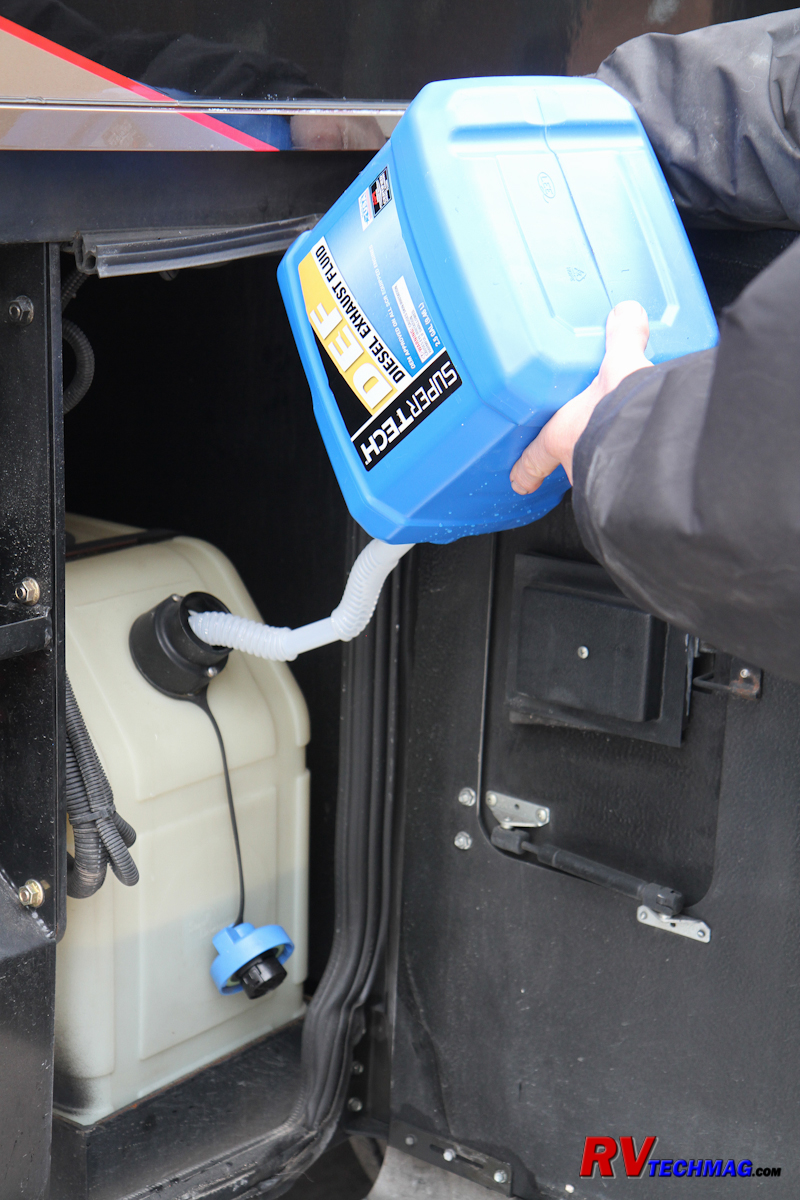
DEF tanks can be filled with 2.5 gallon jugs as well as by fuel island DEF pumps.
|
|
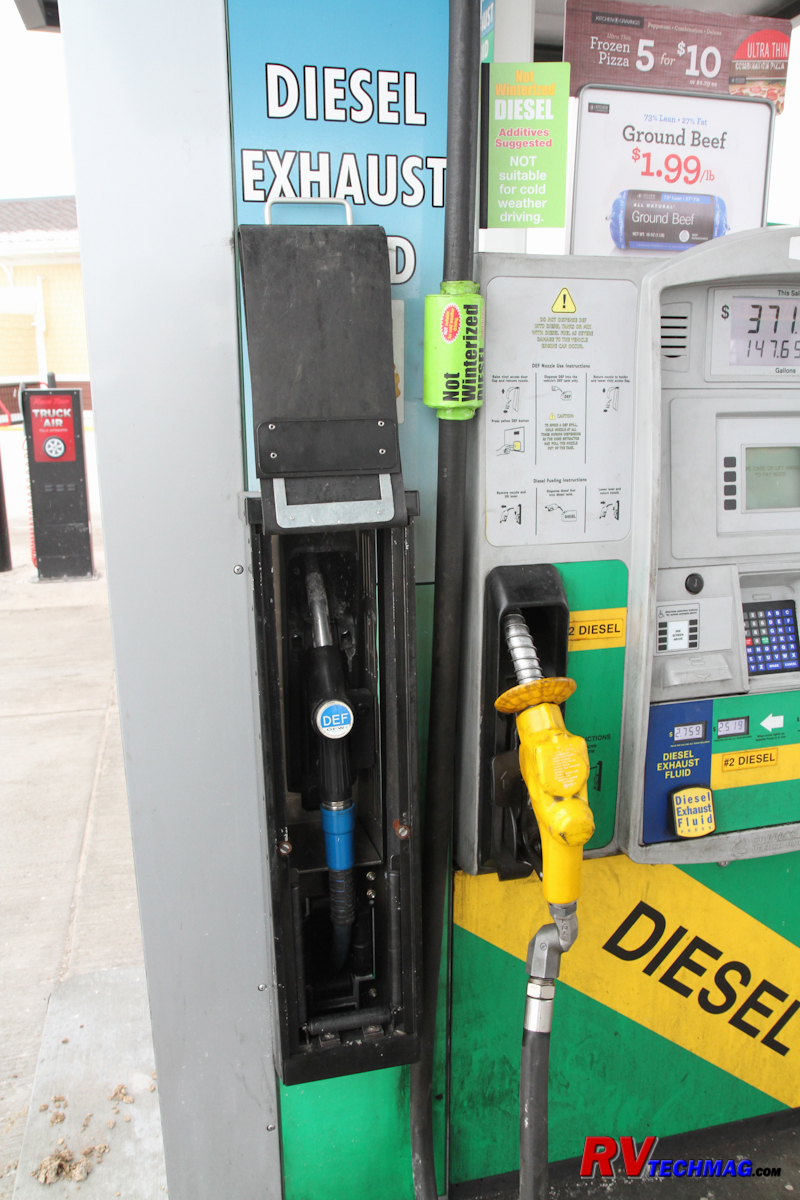
DEF pump nozzles are located next to the diesel fuel pump nozzles. DEF is never pumped through the asme nozzle as the diesel fuel.
|
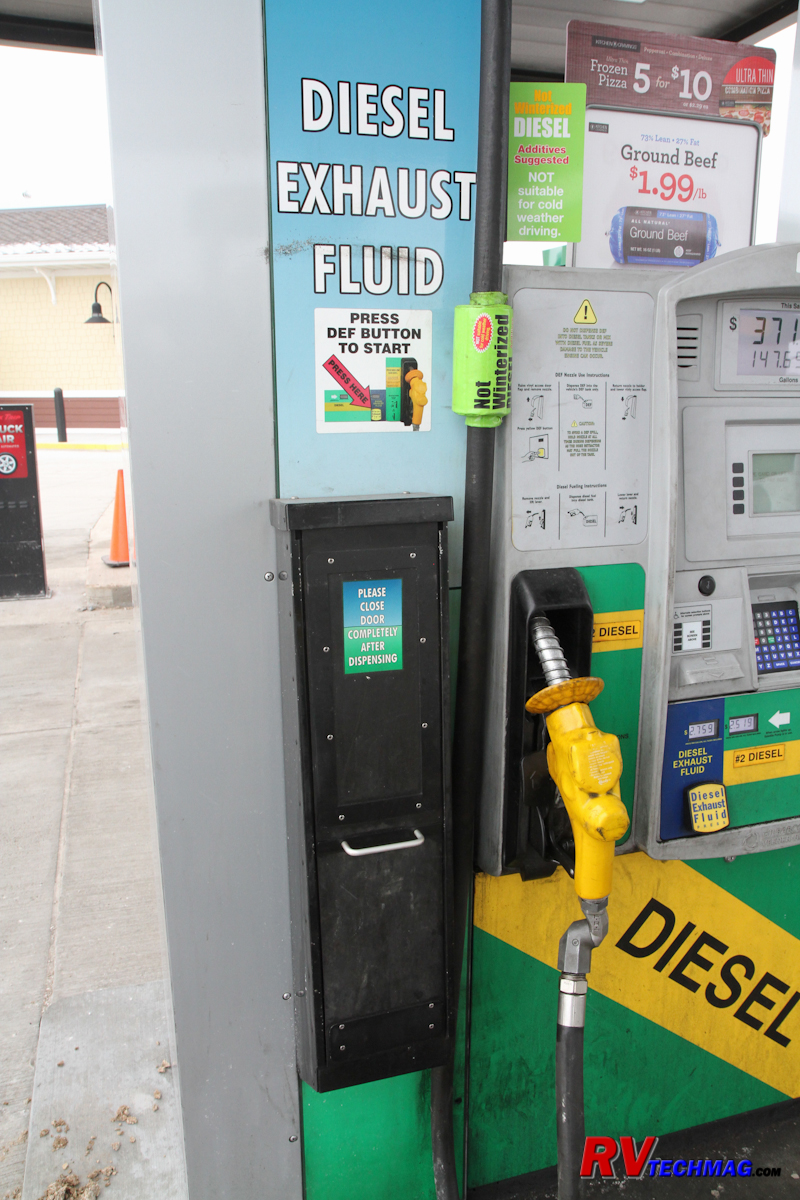
DEF pump nozzles are stored in a heated compartment with a flexible magnetic cover.
|
DEF is always stored in its own dedicated tank and should never be put into a diesel fuel tank, nor should diesel fuel ever be put
into a DEF tank. If you put diesel fuel into the DEF tank it will damage the SCR system and you will have an expensive repair bill. If you do put fuel into
the DEF tank do not start the engine. You will need to call a service center and have them remove the diesel fuel from the tank before moving the coach.
Diesel fuel is lighter than DEF and will float to the top as long as you don't stir it up by starting the engine. Once you get the tanks cleaned out you can
refill with fresh DEF and start the engine. There are a few safeguards in place to help prevent this. Truck pump diesel fuel nozzles are 0.87" (22mm) in
diameter, which is larger than DEF fuel nozzles, which are 0.75" (19mm) in diameter so it would be extremely difficult to put the diesel fuel nozzle into a
DEF tank. DEF tank caps are also blue in color and are labeled to help identify them as DEF caps.
It is possible to insert the smaller DEF nozzle into a diesel fuel tank filler neck. Once again, do not start the engine. DEF
contains 67.5% water and will wreak havoc on your fuel injection system and can explode fuel injector tips. You'll need to have the fuel tank purged of
DEF before continuing. Some bulk DEF pumps have a magnetic switch located in the nozzle. This safety switch will the presence of a magnetic ring in the DEF
tank's filler neck and will prevent the flow of DEF if it does not sense the magnet. But not every DEF pump nozzle has those magnetic safety switches so
you do need to be careful in which tank you are putting your DEF and to choose the correct nozzle. This may also affect your ability to refill plastic
2.5 gallon jugs with pump DEF. The plastic jugs don't have a magnetic neck so any pump DEF nozzle equipped with a magnetic safety switch won't turn on
and allow any DEF to flow. You can use an adaptor device, such as a Magnevator, which slips over the pump's nozzle to allow flow if you choose to refill
your plastic jugs.
|
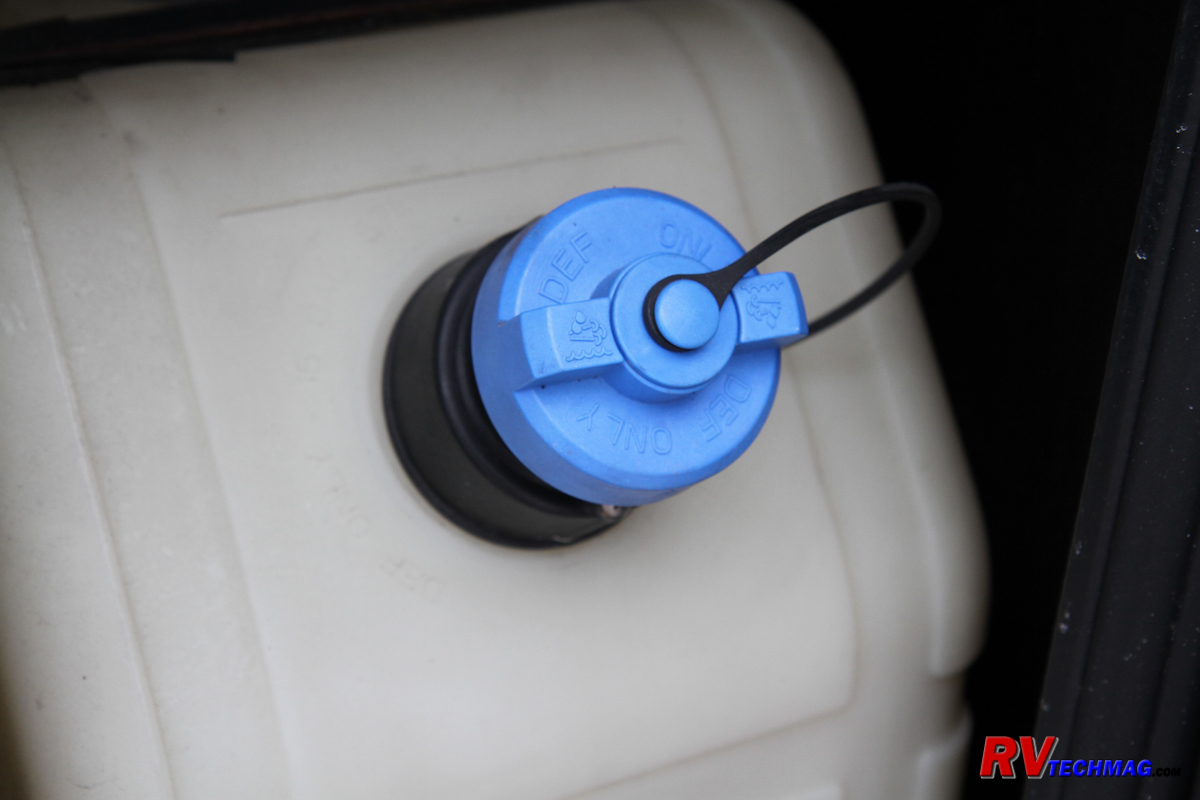
DEF tank filler caps are blue in color, are labelled for DEF-only use aqnd include a magnetic ring to activate DEF pnmp nozzles.
|
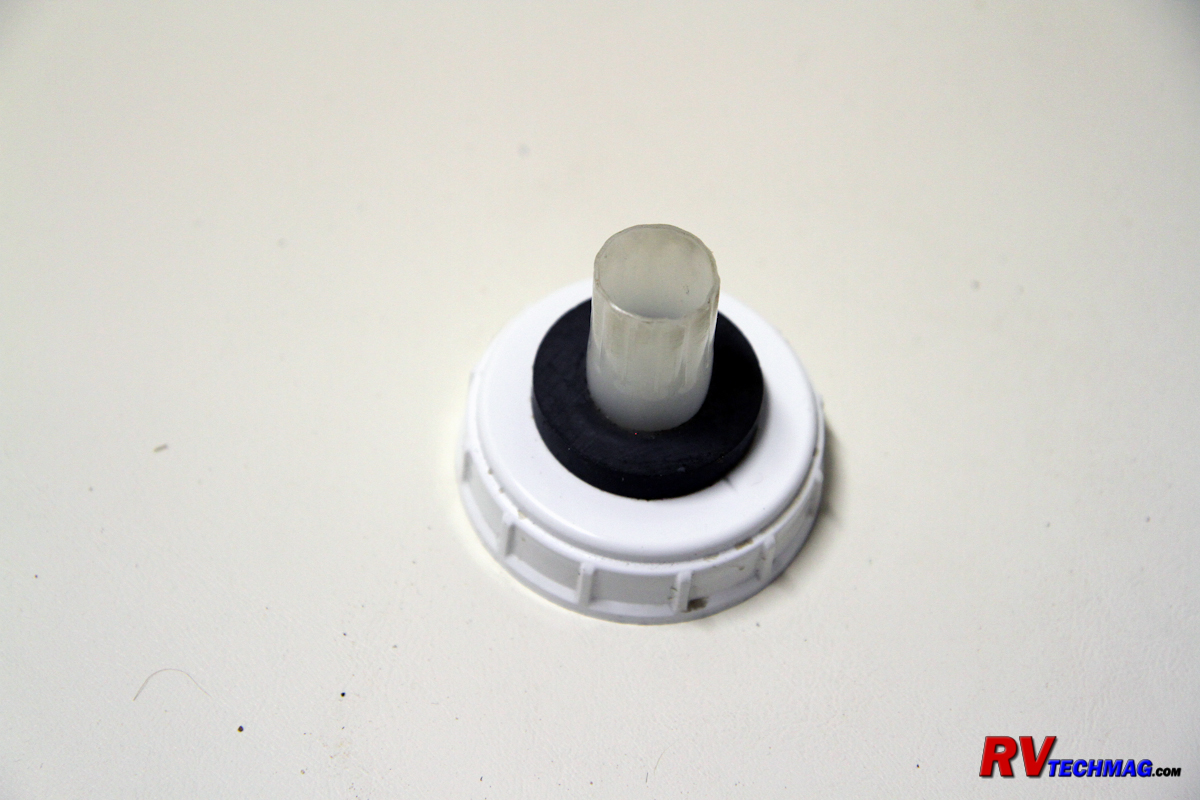
A Magnevator adaptor can slip over the DEF pump nozzle and is equipped with a ring magnet to activate the
pump nozzle when used to refill portable jugs that have no magnetic filler neck.
|
DEF isn't hazardous to handle but it can stain clothes if you spill any on your clothing. If you do spill DEF on your clothes just
wash it away with water. If you spill any on the ground just wipe it up with a paper towel or rinse with water. Any residue that remains will turn into
crystals, which will also wash away with water. DEF is corrosive to carbon steel, copper and aluminum so its best to rinse any spills there with water as
well to prevent corrosion.
DEF in Your RV
Now that we've learned about DEF itself, let's take a look at how it is used in your motorhome's emissions system. It all
begins with a tank designed for storage of the DEF. This tank is polypropylene to prevent corrosion between the DEF and any metals. The DEF tank has
a blue poly filler cap wit a bayonet lug that seals tight to prevent evaporation of the DEF. There are limits to the hose lengths between the DEF tank
and the emissions system so the DEF tank needs to be located fairly close to the engine. On a front engine 18 wheeler the DEF tank is located up front
on the driver's side, right next to the fuel tank. Accordingly, the DEF pumps at truck stop fuel islands are right up front next to the fuel pump
on the driver's side. That might work for a diesel powered Super-C motorhome but for a rear engine diesel class A that's too far away because the DEF
tank needs to be at the rear of the vehicle. The typical exhaust and emissions system on a diesel pusher is at the right-rear corner of the coach, right
next to the engine. The DEF tank was typically located in that same area. Have the DEF tank filler on the curb-side of the vehicle at the rear made it
difficult for motorhome driver's to utilize pump DEF at truck stops but recent improvements in RV chassis design have allowed for a driver-side filler
tube and crossover pipe to allow filling from DEF pumps, although the coach does need to pulled after quite a bit after filling up with diesel fuel in order
to reach the DEF filler, which can still be a bit of a hassle if the truck that fueled ahead of you is inside doing his paperwork and blocking the way so
that you can't pull ahead until he leaves. With the low price on SuperTech DEF 2.5 gallon jugs the difference in cost between pump DEF and plastic jugs is
just pennies.
DEF freezes at 12 degrees Fahrenheit and it does need to be kept warm enough to flow. The DEF system utilizes warm engine coolant
and circulates it though the DEF tank to warm the DEF to the point where it will flow, which does happen fairly fast. In cold temperatures the DEF won't
initially flow but the emissions controls will allow the engine to operate while the DEF warms up without throwing an error code. Whenever you stop your
engine you might hear an electric pump located at the right-rear corner of the coach that continues to run after you shut down your engine. This pump will
run for approximately 60 seconds and will purge all of the DEF from your valves and lines to prevent damage from freezing. DEF does expand about 7% when
frozen so be sure to keep a bit of air space above the DEF in the tank to allow for expansion during cold weather. The filler neck in most curb-side DEF
tanks is low enough to prevent overfilling but if you have a driver-side DEF filler extension you might want to keep an eye on that.
The DEF is then sent to a dosing valve. This electronically controlled valve sprays DEF into the decomposition chamber. This
chamber is part of the secondary emissions tank that also houses the SCR. This assembly is placed after the Diesel Particulate Filter (DPF) in the
exhaust flow pattern. The DPF is both a filter and catalyst that removes carbon particles from the exhaust gas and traps them in a wall-flow filter. At
the same time nitric oxide in the exhaust is converted to nitrogen dioxide in the diesel oxidation catalyst. As the nitrogen dioxide passes through the
wall-flow filter it reacts with the carbon to form carbon dioxide. The exhaust then flows out of the DPF and enters the SCR assembly, where it enters the
decomposition chamber. A light mist of DEF is sprayed through the dosing valve where it forms ammonia through a series of chemical reactions. Together,
the NOx and ammonia pass from the decomposition chamber into the SCR catalyst chamber where they react to form nitrogen and water vapor. The end result
is exhaust with near zero emissions levels.
EPA requirements stat that the emissions system must be fully operational at all times. DEF is a part of the emissions systems
so certain safeguards are put in place to prevent operating the vehicle without DEF being present. A DEF gauge will be provided on the instrument panel
so that the driver knows how much DEF is in the tank. In most cases this will be a series of four LED bars built into the fuel gauge. Whenever
the DEF tank is full, four green LED bars will be displayed. When the DEF level drops to 3/4 tank, three bars will remain green while the fourth will go
dark. As the tank level drops to 1/2, two bars will be displayed. When the tank drops to 1/4, one green bar will be displayed. Once the level of DEF in
the tank drops to 10% the remaining LED bar will change to amber. Typically the LCD Information Center on the instrument panel will display a "LOW DEF"
warning as well as a warning icon. The vehicle will continue to operate normally but by this time you need to seriously think about how much farther you
have to go because you will need to add DEF sooner rather than later. If you continue your drive the LED bar will turn red when the DEF tank level
reaches 5% and the Information Center will now state "ENGINE PERFORMANCE DERATE EMINENT". You now have very little time left to add DEF before your engine
derates and loses power. Once the DEF level drops to 3% the Information Center displays changes to "ENGINE PERFORMANCE DERATE ACTIVATED". At this point
the engine's ECM will derate the engine with a 25% reduction in torque. You'll be down on power but can still limp off e road but as you do so you'll
still be burning DEF, which brings you very close to the final step.
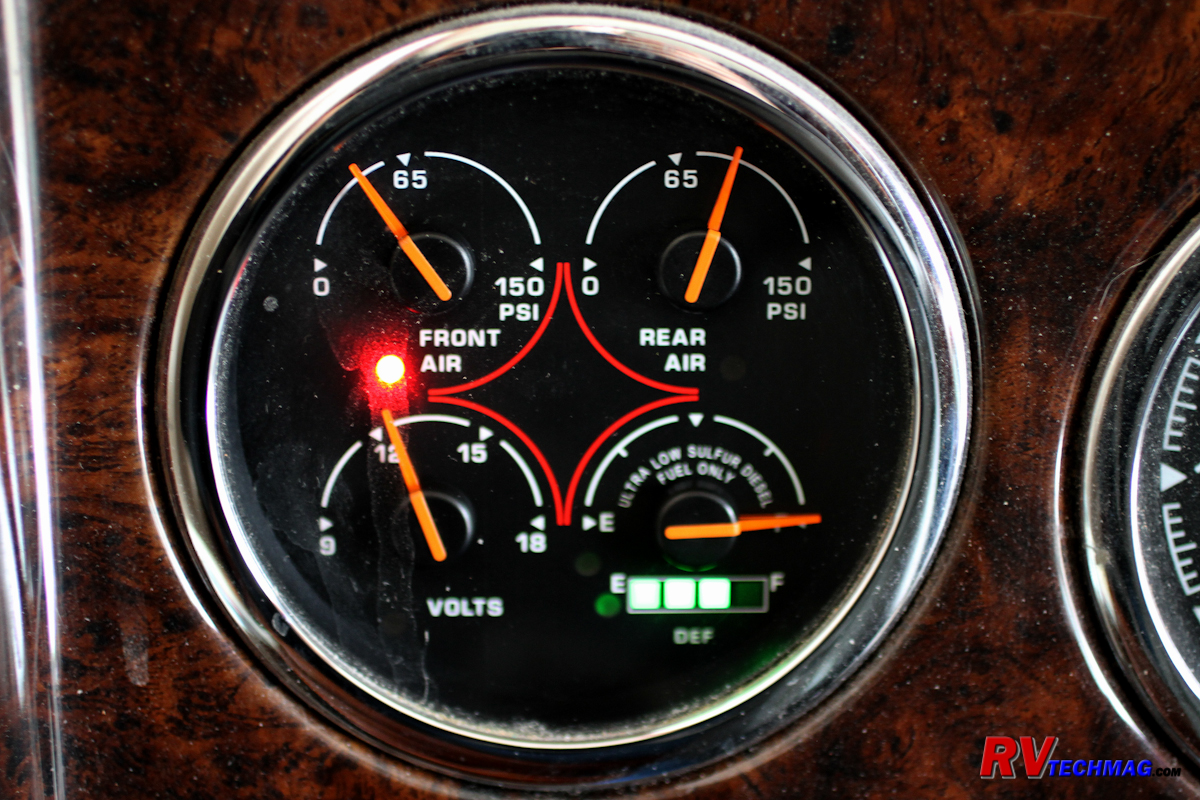
Most fuel gauges are equipped with an LED bar graph that indicates how much DEf is in your tank.
Once the DEF tank gets down to 0% the red LED bar remains illuminated and the Information Center now displays "SPEED RESTRICTION
ON. DEF REQUIRED". Engine torque is limited to 60% and speed is limited to 5 MPH. You can crawl off the road but you'll need to fill the DEF tank to at
least 10% in order to drive to a location where you can top off the DEF tank. Carrying a 2.5 gallon jug or two of DEF is a wise choice, even if you normally
fill your DEF tank from the pump.
DEF systems aren't hard to maintain. The main thing is to use clean DEF. DEF crystallizes over time. If you refill your plastic
jugs with pump DEF be careful that you aren't adding crystallized DEF residue into the tank. DEF gets old so the best practice is to keep it within one year
of age. If you don't drive many miles and you store your RV in winter try to run the tank level down prior to storing your coach. Diesel fuel tanks
should be kept full when in storage to prevent condensation but DEF tanks are just the opposite. Leaving the level down allows for expansion when freezing
and lets you add fresh DEF in the spring with a more recent date. If you plan on storing your coach for a longer period of time the best practice is to
drain the DEF from the tank after one year and replace with fresh DEF every year. This will allow you to run the coach to keep it exercised on a regular
basis. You won't need to fill the tank completely - just enough to cover your exercise warm-ups and keep above the 10% level. It is critical that your DEF
remain at the 32.5% urea level which normally isn't a concern if using fresh DEF. If your DEF has been sitting around a while or if you are suspect that
your DEF jugs may have been tampered with you can use a refractometer design for DEF that will show you the percentage of urea in your DEF. That's not a
bad tool to have around just in case you suspect anything while traveling.
There is a DEF filter that is located alongside the bottom of the DEF tank. The filter is a small cartridge element that is located
behind a screw-on cover. It's designed to be removed with a 1-1/16" 12-point socket but in some cases you might be able to remove it with a channel lock
pliers but the odds of damaging the cover is high so I recommend investing in the proper socket. The filter is up inside the cavity so once you remove it
a bit of DEF may splash out. You won't need a drain pan to catch it but keep your face off to on side when you unscrew the cover while the DEF dribbles
out of the housing at first. Replacement filters come with a small plastic tool that you can use to extract the filter. Just push the tool up into the
filter's center cavity, squeeze the handles to expand the gripper teeth and yank the filter right out of the housing. Push the new filter into the housing
and reinstall the cover and you'll be set for another year. Many owners tend to forget about this filter but a plugged or restricted filter generally
leads to a failed DEF pump, which is an expensive repair so don't neglect this little bit of maintenance.
|

A DEF filter is a normal service item and comes with an extraction tool to make removing the filter element much easier.
|
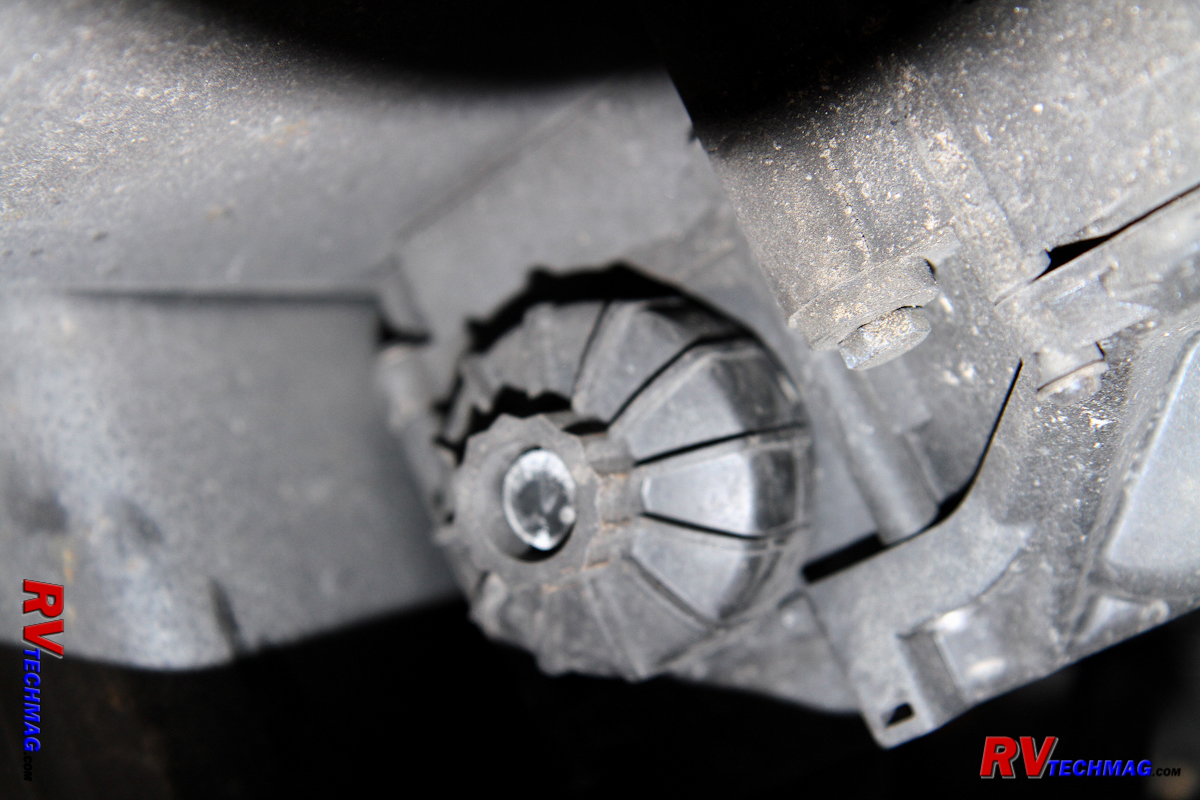
The DEF filter is located near the bottom of the DEF storage tank and is accessed by removing the spin-on filter cover.
|
|
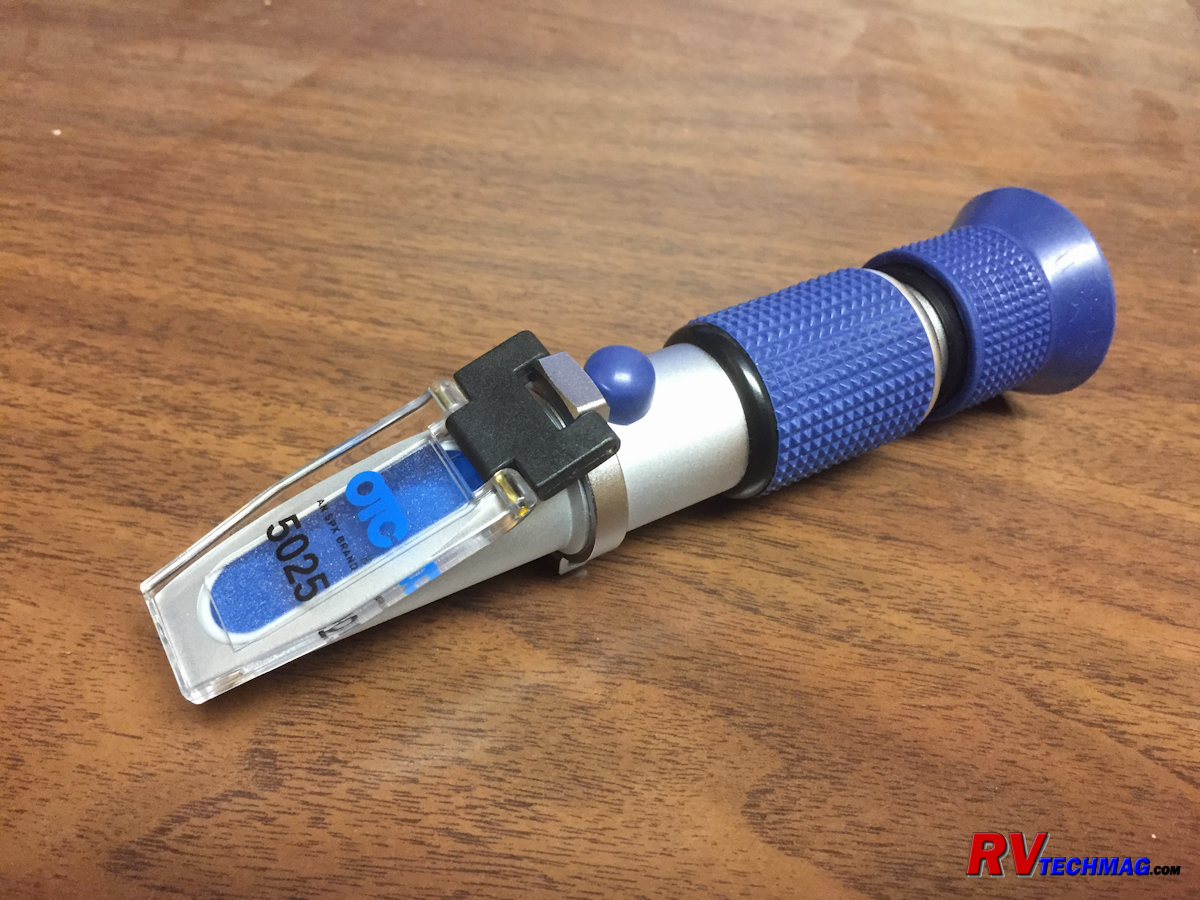
A DEF refractometer can be used to verify the urea level within the DEF.
|
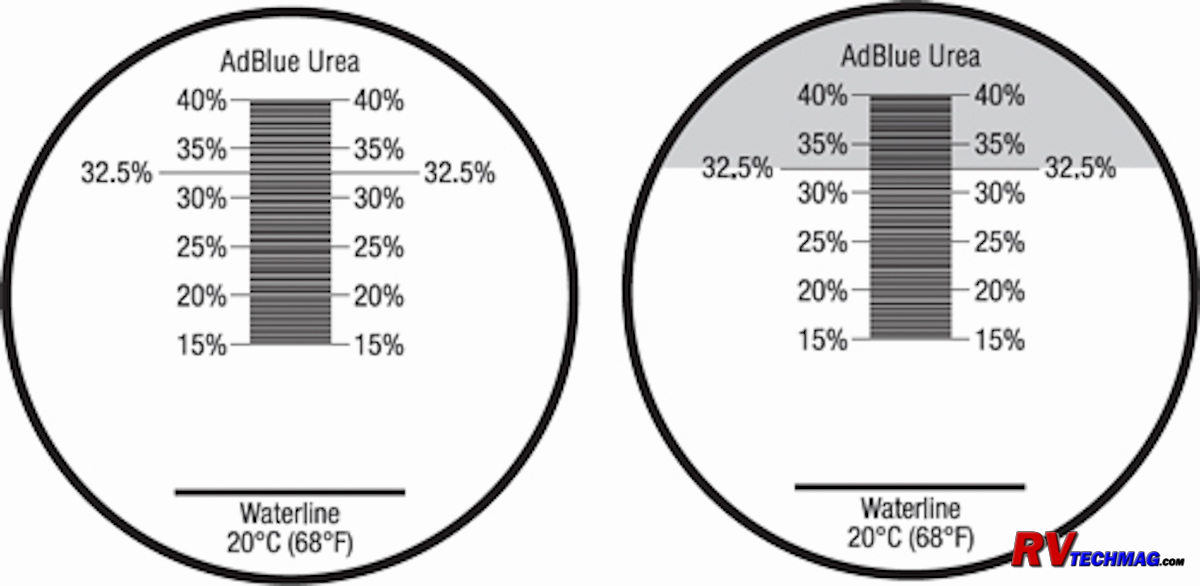
The refractometer will display the exact percentage of urea by sampling a few drops and looking through the lens.
|
Summary
DEF isn't that bad of a deal once you understand it. It is one more thing to deal with but it's just part of keeping the air
safer to breathe. If you talk to any service techs who have to run diesel powered motorhomes in the service bay you'll find they greatly appreciate the
motorhomes that use DEF as it much easier on their eyes and lungs. The cost of DEF is minimal and pretty much offset by fuel economy gains and the filter
change isn't an expensive service cost either and is easily a 5 minute DIY project.
Return to Home Page
If you enjoyed this article be sure to recommend RVtechMag.com to your friends, like us on Facebook or Twitter
or subscribe to our RSS feed.



|



















